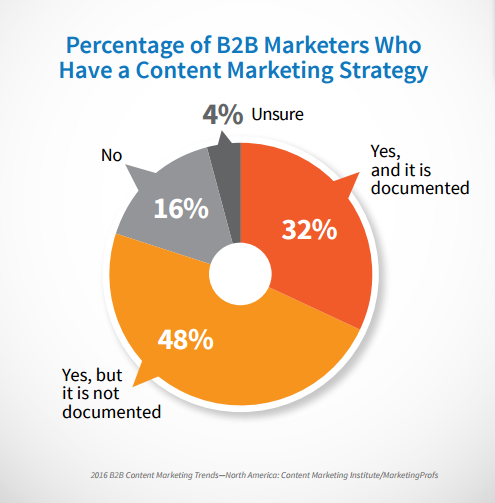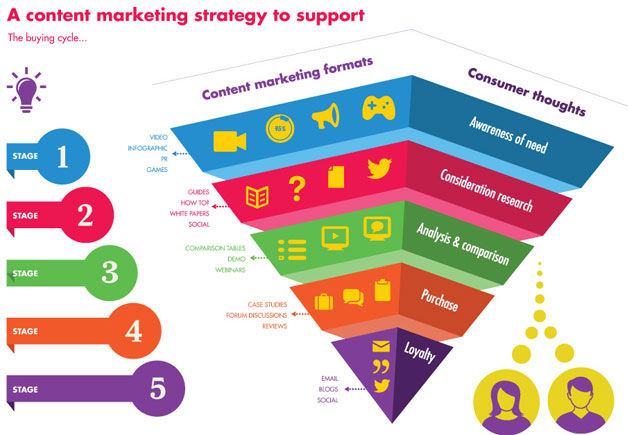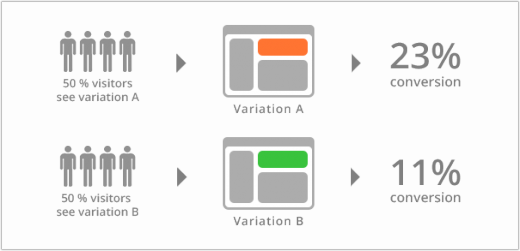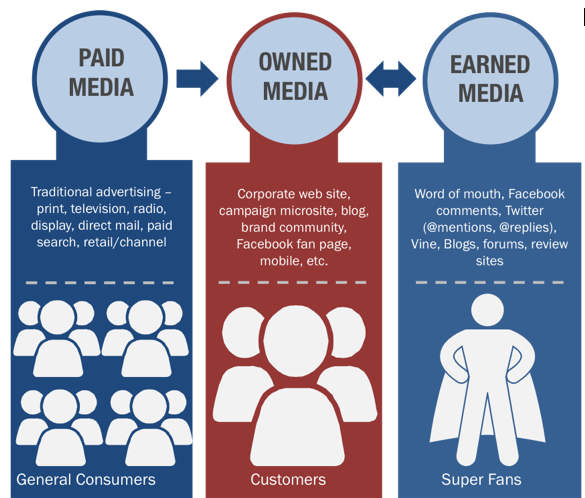Content marketing is vital to most businesses, with its success affecting many positions that complement each other. How do you ensure however that your strategy is effective?
78% of CMOs see custom content as the future of marketing, and this is only an example of how marketers value the rising focus on content.
However, there are many challenges to deal with until you create a successful content marketing strategy, so it’s time to start improving the chances of reaching the set goals by eliminating any common mistakes.
1. Not documenting content marketing strategy
According to Content Marketing Institute and MarketingProfs, 48% of B2B marketers don’t have a documented content marketing strategy. Only 35% of them have their strategy documented, which leads to a clear plan regarding their goals and their expectations from their efforts.
A documented content marketing strategy is a commitment that helps you stay focused both in short and long term, while it also gives you a better understanding of the content you’re creating, along with the set strategy.
Source: Content Marketing Institute
Solution
Start by writing down your current strategy and organise your content with a content calendar for your daily and weekly planning, a content audit for the analysis of your content, a description of your audience personas and of course, a formal marketing plan that will explain your set strategy for your business.
If you want to read more about it, Chris Lake shared with us a very useful guide to starting a content strategy from scratch.
2. Content should serve a purpose (CTA)
Content marketing may be a popular term, but still, not everyone creates content with a specific purpose in mind.
Whether it’s lead generation, engagement, or brand awareness, every piece of content should provide a call-to-action (CTA), in order to increase its effectiveness by guiding the readers on what their next click could be.
It’s so easy nowadays to lose a reader’s interest, so why should you make it even easier for them?
Solution
Not every content serves the same purpose, but it certainly should serve one to exist in your brand’s strategy.
Which content aims for an increase of engagement and what should you create to generate new leads?
According to Content Marketing Institute, 84% of marketers consider “brand awareness” the most important goal of content marketing, which means that right after setting the goal, it’s time to experiment with the best way that it can be achieved.
Source: Content Marketing Institute
3. Not spending enough time on content
As obvious as it may sound, marketers don’t always spend the required time on the actual content, as they may focus on different aspects of content marketing while trying to amplify it.
However, no goal can be achieved if the content is not appreciated by the audience. Appreciation could be defined from:
- Engagement
- Social recognition
- Increase of audience
- Number of clicks
All these require the necessary amount of time spent for each type of content, depending on its length, its purpose, or its chances of being repurposed.
Solution
Focus on the quality of the content, whether it’s a blog post or an infographic, in order to ensure that it will be appealing enough to meet your expectations.
For example, when producing a blog post, or a white paper, here’s what you need to consider:
- Is the content clear of any grammatical errors?
- How is the formatting?
- Have you used relevant and appealing images?
- Is the content serving its purpose?
- Have you used a CTA properly?
- Is the topic right for your audience?
- How do you manage to hook the readers?
4. Forgetting SEO
Search engine optimisation is the process of improving your content in order to help search engines discover it.
It’s not enough to produce good content if you’re not helping the audience discover it and search engines may be useful on that. As you manage to increase the quality (and quantity) of your content, your ranking will start increasing in the search results and this could lead to an increase of traffic back to your site.
Even if it’s not your actual job to know everything about SEO, you can still help your content improve its “crawlability”.
Solution
Here’s a list of quick tips on how to optimise your posts for SEO and hopefully they can help you understand that quality content and SEO make a great match for every successful content marketing strategy.
5. Ignoring your audience
It’s great to have a documented content marketing strategy full of quality content that’s perfectly optimised for SEO, but this may be useless if your content is not suitable for your audience.
The suitability of the content highly depends on its relevance, as this will be the best metric that will define whether you’re getting closer to your goals.
Content out of context may lead to a waste of time and budget that no business would enjoy, which means that it’s time to learn more about your audience, including the insights to your content strategy.
Solution
Before you start measuring the type of content that works better for your audience, you need to start learning more about the users you’re targeting.
The idea of creating (or updating) your buyer personas is a good start, as this is an opportunity to analyse your target audience and personalise them by creating a deeper connection with their habits and their needs while consuming content.
Except for the buyer personas, it is also useful to learn more about the buyer’s journey and measure how your content can fit into each phase, which will be helpful both for your content’s effectiveness, but also for the new content you’ll be creating from now on.
Image source: Adido
A solid understanding of your audience may lead to many useful observations about your strategy and even to surprising insights, so never underestimate this task.
6. Not testing new ideas
A successful content marketing strategy cannot overlook the testing phase, as it allows marketers to draw useful conclusions about numerous aspects of their strategy, from its planning, to the formatting and the actual implementation of it.
Experimentation may occur in:
- Email marketing (to improve the effectiveness of a mail campaign)
- Content calendar (to find the best content schedule)
- Content types (to test the types of content that work better)
- Call-to-action (to examine which CTA leads to the desired results)
- Headlines (to pick the most effective headline for your blog posts)
- Visual content (to decide on the best visuals for your content)
- Timing (to test the best times to deliver your content)
- Engagement (to analyse which content is the most engaging)
Solution
Add testing in the procedures you need to perform regularly and use various types of metrics to analyse what contributes to the success of your content marketing.
For example, in email marketing it’s a good idea to create two versions of an email campaign, testing what leads to an improved click rate and discover what could affect the performance of your campaigns.
Image source: Thenextweb
When creating a call-to-action, you can use a different link for each CTA, in order to analyse the effectiveness of the two and decide which one works better for your audience.
In visual content and social media posting, there may be a significant difference from one image to another, depending on the social network, your audience, or the content you’re promoting. Make sure you experiment enough until you decide what’s the best image to use.
7. Not measuring the content’s performance
There’s no need to create content and maintain a content marketing strategy if you’re not able to analyse its performance and keep track of its metrics.
The measurement of your efforts help you understand the best parts of your content marketing strategy, but also what underperforms, which may even be more important, especially if you spot it as early as possible.
Image source: Ludismedia
Solution
From Google Analytics to social media and email marketing metrics, any measurement is beneficial and they should be carefully examined to help you understand your audience, its behaviour and what contributes to the performance of your content.
A spreadsheet with all the measurements would help you stay organised and consistent with the metrics, so there’s no need to delay this task anymore.
8. Underestimating visual content
Did you know that posts containing at least one image tend to perform better in terms of SEO? Visual content is becoming an important part of a content marketing strategy nowadays, whether it’s used in a blog post, or in the creation of a video for your social networks.
Although it’s still complementary to written text, it may affect the engagement of your content, as it manages to evoke the right emotions to grab the audience’s attention.
Solution
It may be challenging to find the right image for every piece of content you’re creating, or even to find the resources to create an infographic, a GIF, or a video, but there are many free tools and sites to discover that will help you to never run out of visual content again.
For example, here are the best sites to find free image resources.
9. Ignoring distribution
The easiest way to see your content marketing strategy fail is to ignore, or underestimate the distribution of your content.
How will the audience discover your content if you don’t promote it properly?
It may not be common to completely refuse to promote your content, but it’s common to perform a basic promotion, or one that’s not tailored for the specific content and your audience, which equally affects the chances of reaching your goals.
Solution
The distribution of your content should rely on multiple channels, with each one serving a different purpose, from engagement to lead generation.
Your marketing efforts are divided among paid, earned and owned media, with all of them being of equal importance, requiring from you to find the perfect balance that will maximise your chances of success.
Image source: Business2Community
You don’t have to promote your content to every single platform, but rather to the ones that are relevant to your audience. What’s more, it is vital to understand the importance of repeat promotion, which means that distribution does not end once you’re promoting your content for the first time.
Your metrics may help you discover the best platforms, but also the best times, to promote your content, improving its effectiveness, while forming a complete content marketing strategy.
Takeaway
Content marketing should be a perfect mix between content creation, promotion, engagement, testing and measurement and if you feel you’re left behind in any of these steps, then maybe it’s time to refresh your content marketing strategy, one step at a time.
(Don’t worry, we’ve all been guilty of the above mistakes)







No comments:
Post a Comment